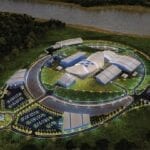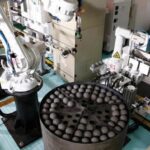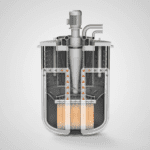Many experts believe small modular reactors (SMRs), which are generally classified as nuclear power reactors with an electrical output of 300 MW or less, offer great promise for supplying the world with carbon-free energy. Several SMR designs are under development by companies around the world including NuScale Power, GE-Hitachi, Terrestrial Energy, TerraPower, Toshiba, X-energy, and others. Among the benefits touted by proponents of SMRs are improved reactor safety features, quicker plant construction, and reduced costs for the units.
Yet, there has been some heated debate on the amount of nuclear waste that might be generated by a fleet of SMRs. In May 2022, findings from research conducted by a team that included a former U.S. Nuclear Regulatory Commission (NRC) chairperson and experts from Stanford University suggested SMRs will generate more radioactive waste than conventional gigawatt-scale nuclear units. That research was disputed by NuScale, which said there was “a factual error in the paper.”
Specifically, Jose N. Reyes, Chief Technology Officer and co-founder of NuScale, said, “The authors mistakenly assert that NuScale Small Modular Reactors (SMRs) will produce significantly more spent nuclear fuel (SNF) than existing Light Water Reactors [LWRs]. The basis for this statement is their analysis of the NuScale 160 MW thermal core as opposed to the NuScale 250 MW thermal core implemented in NuScale VOYGR plants.” Reyes noted at the time that NuScale’s 250-MWt design has an average fuel burnup and a design basis maximum exposure that are within the values typically observed in the existing fleet of light water reactors. Now, NuScale has some independent research to support its claim.
Nuclear Waste Attributes of SMRs
In November, Argonne National Laboratory (ANL) completed a study intended to evaluate the nuclear waste attributes of SMRs, with the results compared to a reference large pressurized water reactor (PWR). Dr. Taek Kyum Kim, manager of Nuclear Systems Analysis at ANL and lead author of the report detailing the studies findings, said, “All told, when it comes to nuclear waste, SMRs are roughly comparable with conventional pressurized water reactors, with potential benefits and weaknesses depending on which aspects you are trying to design for. Overall, there appear to be no additional major challenges to the management of SMR nuclear wastes compared to the commercial-scale large LWR wastes.”
The ANL study, which was conducted with assistance from the Idaho National Laboratory, assessed the nuclear waste attributes of three small reactors: NuScale’s VOYGR, TerraPower’s Natrium, and X-energy’s Xe-100 designs. VOYGR is a PWR design using the same type of ceramic fuel as found in larger LWRs, Natrium is liquid metal–cooled and uses a metal alloy fuel, and Xe-100 is a helium-cooled reactor that uses pebbles containing TRi-structural ISOtropic (TRISO) particle fuel.
The calculated nuclear waste from each was compared to nuclear waste metrics of a reference large PWR. The nuclear waste metrics used in the study addressed “front-end” wastes generated during the fuel manufacturing process, “back-end” wastes arising from the spent nuclear fuel (SNF), and “end-of-life” wastes from decommissioning of the reactors.
Front-End Waste
Concerning front-end waste, the report says depleted uranium (DU) mass is proportional to enrichment and inversely proportional to burnup and thermal efficiency. Compared to the reference PWR, VOYGR generates 23% more DU mass due to relatively higher fuel uranium enrichment (4.95% vs. 4.5%), lower burnup (49.5 GWd/t vs. 50.0 GWd/t), and lower thermal efficiency (31% vs. 34%).
The Natrium and Xe-100 designs fared better than the VOYGR on front-end waste generation. Even though the uranium enrichment for Natrium and Xe-100 fuels is a factor of three to four higher than that of the reference PWR, the normalized DU mass of Natrium is only 17% higher and Xe-100 is 3% lower than the reference PWR because burnup increases by factors of 2.9 and 3.4, respectively. Additionally, thermal efficiency is higher for both of these designs—41% and 40%, respectively.
Back-End Waste
The authors said back-end metric values are inversely proportional to burnup and thermal efficiency, and affected by reactor-specific design features, such as neutron spectrum and fuel type. Compared to the reference PWR, VOYGR generates 1.1 times the SNF mass and 1.1 times the SNF volume due to relatively lower burnup and thermal efficiency. VOYGR SNF also has slightly higher activity, decay heat, and radiotoxicity.
The Natrium and Xe-100 designs performed better, in general, than VOYGR and the reference PWR, concerning back-end waste. Natrium generates 72% less SNF mass, 42% less SNF volume, and 100-year decay heat is reduced by 52% due to much higher burnup and higher thermal efficiency. Initially, activity is about 40% lower, but long-term activity is 20% to 40% higher due to a higher plutonium content in the SNF. The plutonium content also impacts long-term SNF radiotoxicity, which is 47% higher at 10,000 years.
Meanwhile, the Xe-100 SNF mass and 100-year decay heat are lower by 75% and 35%, respectively. This is again due to much higher burnup and higher thermal efficiency. Normalized activity is initially about 20% lower and continues to drop as the fission products decay. The SNF radiotoxicity is reduced by 66% at 10,000 years as plutonium and minor actinides are minimized. However, the SNF volume is higher by a factor of 12.3 due to the fuel design, which includes large amounts of graphite moderator and non-fuel matrix/coating materials.
End-of-Life Waste
Decommissioning Class A, B, and C low-level waste (LLW) consist of building materials activated by neutrons or contaminated by radioactive isotopes. Greater-Than-Class-C (GTCC) LLW consists of reactor components located near the active core and activated above Class C levels. For PWRs, less than 1% of decommissioning LLW is GTCC.
The decommissioning volume Class A, B, and C LLW for VOYGR is 10% smaller than that of the reference PWR. The decommissioning volume of Class A, B, and C LLW of Natrium and Xe-100 was not calculated, due to a lack of detailed design information on reactor buildings, but the waste arising from disposal of coolants was assessed and found to be minimal.
Compared to the reference PWR, the normalized GTCC volume for VOYGR is a factor of six larger. Natrium includes radial neutron reflectors and Xe-100 includes radial graphite blocks that protect other core structures from activation. These designs do not generate appreciable GTCC LLW if the reflector assemblies and graphite blocks are periodically replaced before they are activated to the GTCC level. However, compared to the reference PWR, Natrium and Xe-100 generate a factor of four and 193 more GTCC volume, respectively, when the reflector assemblies and graphite blocks reside in the core for the reactor lifetimes.
It must be noted, however, that except for the SNF volume, other SNF waste metrics are driven by fundamental physics, while the decommissioning waste is highly dependent on decommissioning technologies used. Therefore, the researchers said, “there is a large uncertainty in the calculated values of the decommissioning waste values given the time available (in decades) for technology enhancement.”
In the end, the ANL report says, assuming appropriate waste management system design and operational optimization, “there appear to be no major challenges to the management of SMR wastes compared to the reference LWR wastes.”
NuScale Weighs In
In a post published on Medium, an online publishing platform, John Hopkins, president and CEO of NuScale, wrote, “What’s important about this independent research is that it validates what we at NuScale have known all along, our VOYGR SMR power plant produces an amount of spent fuel comparable to typical large pressurized water reactors (PWR) on a per GWe-yr basis. Further, the Argonne National Laboratory study found that the waste characteristics of our VOYGR power plant produces less low level waste for decommissioning than the typical large PWR plant and a lower volume of spent fuel compared to graphite moderated SMR designs in development.”
Hopkins continued, “We are pleased to see the merits of our technology more accurately reflected by these recent studies and hopeful that they provide a more useful framework as stakeholders continue to move forward with the deployment of SMR technologies and consider the safe and secure management of spent nuclear fuel.”
—Aaron Larson is POWER’s executive editor (@AaronL_Power, @POWERmagazine).










